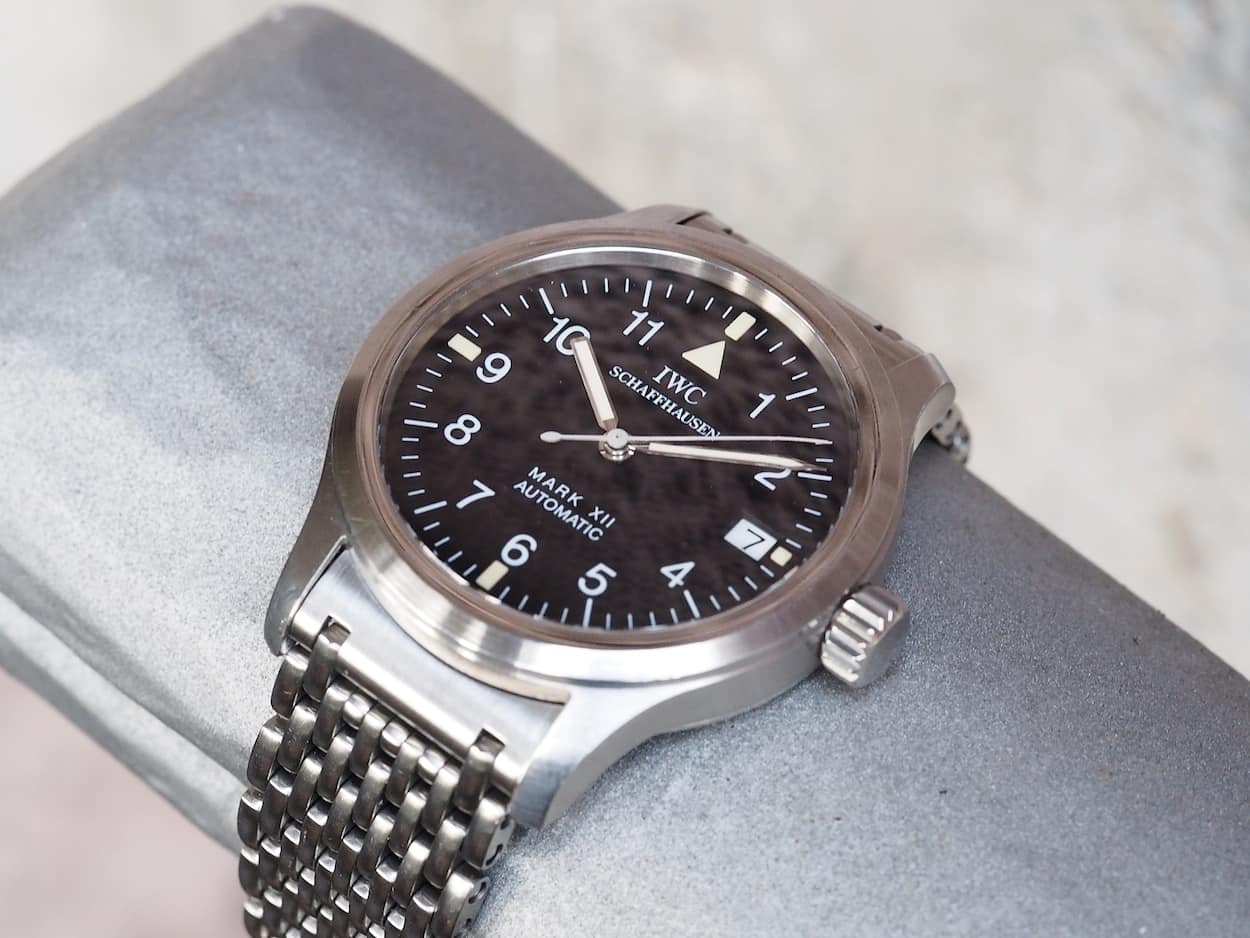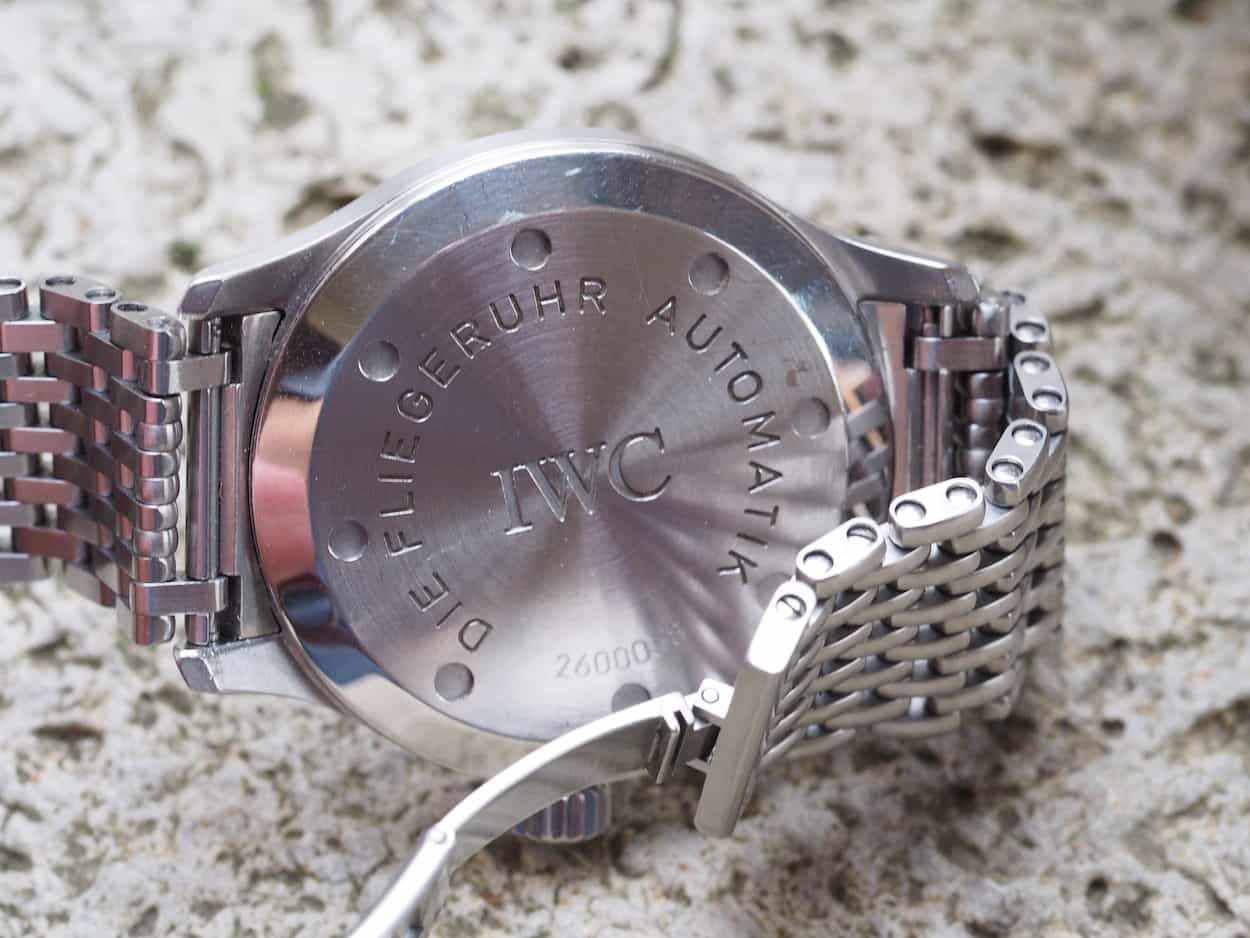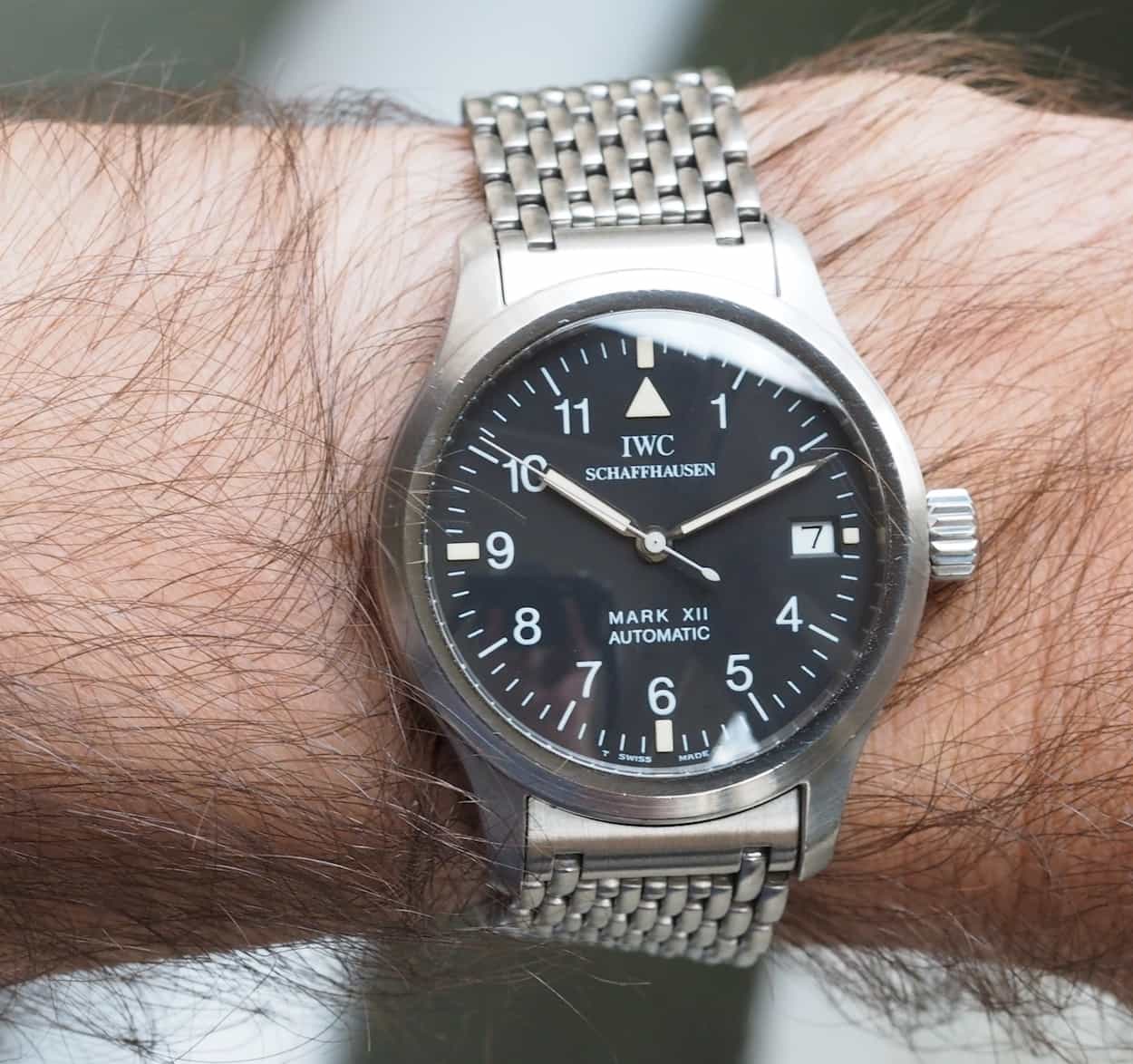#TBT IWC Mark XII
IWC. I have to “mentally squint” a bit now, but the simple recitation of those three letters brings me back to a really amazing watch era of roughly 25 years ago. Yes, I can still remember cruising watch shops with my Dad while on vacation or on the occasional weekend and we kept running into the brand. Of course, that wasn’t just coincidence. No, my Dad was rather taken with a lot of the models that IWC had on offer back in the period. The brand had really reinvented itself by offering what I’d refer to as technically interesting, gentlemanly, sports/tool watches. They were damn expensive, but they oozed understated class. Even the marketing was clean, a bit technical, and left the watches to stand proudly on their own. Plus, they had an amazing thing going with Porsche Design and were marketing some pretty legendary pieces. Within its own line, IWC had some fantastic pieces such as the Ingenieur, the Aquatimer, the lovely Portofino, and others. It’s within the others or other that we’ll spend our time today because today’s #TBT still stands up as one of my all time favorites. Our focus today is the IWC Mark XII.
To kick this off, I’ll simply mention that this IWC is a bit of a paradox. The IWC Mark XII is a well-known watch, but it oddly often escapes mention. More clearly, it’s one of those pieces that so many people admire, but it rarely moves to the front of the list during discussions of top “most wanted”. That, in a nutshell, is the Mark XII. It doesn’t scream for attention, but upon closer inspection, it’s a damn attractive option. Speaking of options, despite its aviation theme, I tend to compare this watch most frequently to another go anywhere favorite: the Rolex Explorer 14270.
The history of the IWC Mark XII is recounted in numerous places all over the web, but I’ll give a brief overview. The world is familiar with the legendary Mark XI powered by the equally iconic manual winding cal.89 movement. This watch was offered to military services and pilots from 1948 up through the 1980’s. It obtained a status as a bona fide pilot’s watch and many spilled over into the hands of eager collectors. While it’s a bit strange that the public lamented the loss of a watch that was never officially offered to them, the folks at IWC apparently smelled an opportunity. Thus, in 1993, the Mark XII was born. Let’s talk a little bit about how this watch looks and some of its other attributes.
If you’re familiar with the Mark XI, then the IWC Mark XII doesn’t stray heavily in the appearance department. The overall dial theme is very similar with a large luminous triangle at 12:00 and luminous rectangles at 3/6/9/12. The printed Arabic numerals and minute track on the XII are also reminiscent of the XI aside from some minor font changes and, of course, there are no military markings. We get the update of “IWC Schaffhausen” versus the traditional “International Watch Co.”, but indicators such as the hands are near spitting images of the older piece.
The only truly glaring change on the IWC Mark XII is the addition of a date window. Normally, I’m dead set against an interruption to my dials and even more so when the date wheel has a white background and, is therefore, the polar opposite of the dial color. In this case, though, when the very idea behind the watch is to allow for extreme legibility and clarity, the easily readable contrasting date works well. Would I rather the date be eliminated? Perhaps, but I don’t find it to be a real bother as I do in most watches.
Looking at the dial overall on the IWC Mark XII, it’s about perfect. In matte black, it looks a lot like the speedometer or instrument of a car or plane. It’s simple, clear and somehow very attractive. I particularly like the purposeful hands and the slender, needle-like white sweep seconds hands. There’s nothing overly special or flashy about the whole execution, but it clearly works as IWC has maintained this formula, although with a highly regrettable date wheel on the current “Mark”, ever since. However, when looking at the dial, it’s impossible to fully appreciate it without taking into account the other physical aspects of the watch. Why? Well, a good dial is nothing without great surroundings.
In the example before you, the IWC Mark XII is made of stainless steel. The case is simple, but well finished with even matte brushing and nice lines demarking the bezel and screw-down case back. The lugs are perfectly in proportion for the 36mm case and the smallish 18mm lug width actually looks nice. Topping it off is a very “pilot-watch” big crown with the then-typical fish on it to denote water resistance (60m in this case). The crown, by the way, is a screw-down unit and is very nicely sized to provide some visual mass to the watch while making adjustments a breeze. You’ll also note that this Mark XII contains something extending from the case: a bracelet.
First off, I don’t consider myself a “bracelet guy”. Whether the watch is new or vintage, I typically go for custom made straps because there are so few bracelet designs that really augment a watch. As an example, I really don’t like the current Speedmaster Pro bracelet. I actually think that the slender polished links take away from the beautiful dial and case. Rolex, on the other hand, is one example where I almost never remove an Oyster bracelet, but then again, I absolutely abhor and refuse to wear such a bracelet with polished center links. So, yes, consider me picky. Coming back to the task at hand, I’m about to make a seriously bold statement. Here it comes: the bracelet on the IWC Mark XII is my absolute favorite in all of watchdom. Bold enough for you?
That’s right, I love the bracelet on the IWC Mark XII. It’s simple enough with its “beads of rice” design, but the execution is sublime. The small links are all solid instead of, say, late 60’s Gay Freres pieces with their folded individual beads. Each row is attached with non-removable bars until you get closer to the double deployant clasp. The thickness of the bracelet is also perfect because it’s quite thin, but just thick enough to be confidence inspiring strength-wise. Oh, and it is silky smooth to the touch despite a micro-matte finishing. Comfort-wise, it’s number one in my book, fits under any type of short, and truly feels like nothing on the wrist. The endlinks are solid and appear to be machined. They’re beautifully finished and the insides are nice to behold when the bracelet is removed. The negatives? Well, I can think of two. First off, the double deployant is a bit of a turn off to some because it doesn’t seem as secure as something like a flip-lock, but it clicks assuredly and allows the bracelet to maintain its slim thickness throughout it’s length. Related to this, when the clasp is closed, there exists a gap between the two sides because the closing pieces “slide” on the deployant when locked down. This is a little strange, but on the other hand, it adds to the vintage character of the watch. Finally, the other negative on this amazing bracelet is that it’s relatively rare. This hardware was an option on the Mark XII and from what I gather, it was an expensive one. Supposedly, the bracelet added another 20% to the price, so it was not an insignificant adder to an already expensive piece. The standard accompaniment with this watch was a more traditional black buffalo strap with an IWC clasp. I have it as well and it’s nice, but the bracelet really adds to the aesthetics. I’ll hit on this again but I find that the bracelet helps erase some concerns about the relatively diminutive size of the Mark XII and I think it dresses the watch up in the process.
One thing we’ve not yet spoken about is the movement within the IWC Mark XII. Whereas the Mark XI soldiered on with a manual winding movement, albeit a great one, the Mark XII switched to an automatic. However, while the brand was using ETA movements in some watches (the Aquatimer as an example), IWC chose to use a movement from one of the Richemont stable mates: none other than Jaeger-LeCoultre. In the IWC, it’s called the cal.884, but it’s based on the JLC 889/2. My talking about this movement isn’t revelatory, but I still find it immensely cool that a tool watch is moved via a powerplant from one of the industry’s most celebrated makers. It’s akin to throwing a Bentley engine into a VW…oh wait…well, you get the idea. The movement hacks and is a 36-jewel unit that runs at a robust 28,800 bph and is adjusted to 5 positions. It’s not beautifully finished in order to keep costs down, but it is housed in a soft iron case to help fend off issues related to magnetism. The issue with the cal.884 is its supposed fragility, sensitivity, and high cost of servicing. I don’t wear this watch everyday and I certainly don’t use it while performing acts of labor, but mine has run without fault for over 2 years and keeps great time. My father happens to own one as well and he wore it daily for a number of years without problems as well. So, who knows, but perhaps the issue is a bit overblown?
I really like wearing the IWC Mark XII. I’ve paired it with everything from its buffalo strap to a basic nylon NATO and, of course, the bracelet; all look great. I do find the bracelet best to show off the beautiful simplicity of the case and dial. Plus, it ups the quality quotient and makes the watch feel more versatile to me. Yes, the IWC Mark XII is the rare sports watch that can pull duty in about any situation. Case in point, I actually received this watch from my now-wife before we were married in 2013 and I wore it on the day of our wedding. Granted, I didn’t wear a tuxedo, but I thought it looked great with my suit. The next day, the IWC felt right at home by the pool as we started our honeymoon. So, yes, it’s versatile and attractive.
Look, if you expected me to join a vocal chorus of IWC detractors, I won’t. While the brand’s current lineup isn’t really to my tastes due to their size and a return, in some cases, to outsourced movements, I do like the look of several of their models. That being said, IWC’s “run” during the early 1990’s up through the early 2000’s marks one of the most glorious modern periods ever by a watch company and perhaps because it was a time of discovery for me, I’ve had a hard time forgetting them. This is really why I hunted for an IWC Mark XII several years ago. Finding one wasn’t overly difficult and due to their neo-vintage status, box and papers are often included. The trickier part is finding one in good condition with the fantastic bracelet. Good, complete pieces with bracelet tend to run in the $3,000 – 4,000 range and those with bracelets in good shape tend to run to the higher end of, if not slightly above, this spectrum. Factor in a service as well. Some things to look for are the original tritium dial and hands. These have yellowed nicely by now and service dials are present out there. Likewise, it’s a small issue, but I have seen service crowns without the fish on them. I like originality, but a replacement is at least likely to hint at a service by IWC. Oh, and while I don’t own one, I can absolutely vouch for the absolute beauty of the 18k gold version. It’s a stunner and even has the gold hallmarks visible on the side of the case. Likewise, a platinum version was made with a blue dial that is interesting. Finally, a limited titanium version was made in collaboration with SAAB (the ex car company), but note that it contained an ETA-based movement.
The next time you’re in the market for a utile, but elegant watch, I’d highly recommend trying on an IWC Mark XII. It fits beautifully and oozes quality. Plus, it’s a great alternative to the multitude of Rolex models out there from the Explorer to the Datejust. I hope you enjoyed taking a look at one of my more favorite watches and you’ve also seen that I can stray beyond the world of chronographs! Until next week…

























